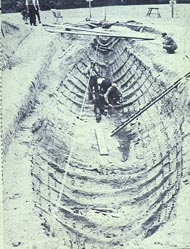
ARTH Courses | ARTH 212 Syllabus | ARTH 212 Assignments
Sutton-Hoo Ship Burial
We will begin our discussion of Hiberno-Saxon Art with an examination of the so-called Sutton Hoo Ship Burial. Shortly before World War II, archaeologists uncovered in East Anglia a remarkable find: an apparently early seventh century grave monument made for an Anglo Saxon king. The monument was in the form of a long boat measuring approximately 86 feet. Although the wood the boat was made of has long since disintegrated, nails and the impressions in the earth have allowed its reconstruction:


The absence of bones has led archaeologists to identify the monument as a cenotaph, or memorial. Scholars have long pointed to the parallels between this find and the following descriptions of funerary practices in the Old English poem Beowulf.
The poem opens with the following description of the funeral of the king Scyld:
Then Scyld departed at the
destined hour,
that powerful man sought the Lord's protection.
His own close companions carried him
down to the sea, as he, Lord of the Danes,
had asked while he could still speak.
That well-loved man had ruled his land for many years.
There in the harbor stood the ring-prowed ship,
the prince's vessel, shrouded in ice and eager to sail;
and then they laid their dear lord,
the giver of rings, deep within the ship
by the mast in majesty; many treasures
and adornments from far and wide were gathered there.
I have never heard of a ship equipped
more handsomely with weapons and war-gear,
swords and corselets; on his breast
lay countless treasures that were to travel far
with him into the waves' domain.
They gave him great ornaments, gifts
no less magnificent than those men had given him
long before, when they sent him alone,
child as he was, across the stretch of the seas.
Then high above his head they placed
a golden banner and let the waves bear him,
bequeathed him to the sea; their hearts were grieving,
their minds mourning. Mighty men
beneath the heavens, rulers in the hall,
cannot say who received that cargo.
The following passage describes the funeral of Beowulf himself:
Then, on the headland, the
Geats prepared a mighty pyre
for Beowulf, hung round with helmets and shields
and shining mail, in accordance with his wishes;
and then the mourning warriors laid
their dear lord, the famous prince upon it.
And there, on Whaleness, the heroes kindled
the most might of pyres; the dark wood-smoke
soared over the fire, the roaring flames
mingled with weeping --the winds' tumult subsided--
until the body became ash, consumed even
to its core...
Then the Geats built a barrow on the headland--
it was high and broad, visible from far
to all seafarers; in ten days they built the beacon
for that courageous man; and they constructed
as noble an enclosure as wise men
could devise, to enshrine the ashes.
They buried rings and brooches in the barrow,
all those adornments that brave men
had brought out from the hoard after Beowulf died.
They bequeathed the gleaming gold, treasure of men,
to the earth, and there it was before.
Then twelve brave warriors, sons of heroes,
rode round the barrow, sorrowing;
they mourned their king, chanted
an elegy, spoke about that great man:
They exalted his heroic life, lauded
his daring deeds/
Thus the Geats, his hearth-companions,
grieved over the death of their lord;
they said that of all kings on earth
he was the kindest, the most gentle,
the most just to his people, the most eager for fame.
You Tube Clips from the 1958 movie The Vikings
Included among the objects was this cloisonné purse:
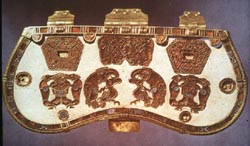
This purse contained a variety of coins that have allowed numismatists to date the monument to the second quarter of the seventh century:
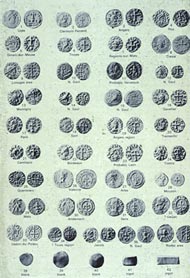
The 37 coins were supplemented by three blanks and two ingots. An intriguing hypothesis is to understand the 40 coins (37 coins + 3 blanks) were the wages for the oarsmen responsible for rowing the ship to its destination in the afterlife while the two ingots were the pay for the steersman.
The dating of the coins
to about 625 have led scholars to propose the identification of the East Anglian
king as Raedwald who died about 624 and 625. Bede in his History of the English
Church and People identifies Raedwald as the first East Anglian king to
have become converted to Christianity. This would be consistent with a pair
of spoons found in the ship burial. One is inscribed with the name Saul and
the other with Paul.  These were apparently christening spoons referring to Saul
who became Paul after his conversion to Christianity. What we know of Raedwald
is that he subsequently relapsed into paganism and apparently kept shrines to
both Christian and pagan dieties. Bede (History of the English Church and People, II, 15) presents the following account of Raedwald:
These were apparently christening spoons referring to Saul
who became Paul after his conversion to Christianity. What we know of Raedwald
is that he subsequently relapsed into paganism and apparently kept shrines to
both Christian and pagan dieties. Bede (History of the English Church and People, II, 15) presents the following account of Raedwald:
| EDWIN was so zealous for the worship of truth, that he likewise persuaded Eorpwald, king of the East Saxons, and son of Redwald, to abandon his idolatrous superstitions, and with his whole province to receive the faith and sacraments of Christ. And indeed his father Redwald had long before been admitted to the sacrament of the Christian faith in Kent, but in vain; for on his return home, he was seduced by his wife and certain perverse teachers, and turned back from the sincerity of the faith; and thus his latter state was worse than the former; so that, like the ancient Samaritans, he seemed at the same time to serve Christ and the gods whom he had served before; and in the same temple he had an altar to sacrifice to Christ, and another small one to offer victims to devils. |
Included in the treasure are some of the finest pieces of barbarian metalwork that have come down to us like this large gold belt buckle:

There was also found a pair of cloisonné shoulder clasps:
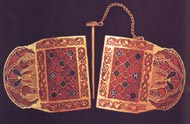
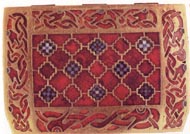
There was also found the remains of a warrior's helmet:

ARTH Courses | ARTH 212 Syllabus | ARTH 212 Assignments